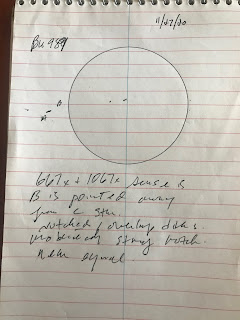BU 989 AB: 508; 1067x: Overlapping disks, moderately strong notch, near equal. This has an astonishingly short 11.57 year period. At apastron now, it will be at periastron by 2025, and widen agin -- it will be fun to see this close then open again.
21H 44M 38.70S +25° 38' 42.0" P.A. 325.5 SEP 0.15 MAG 4.94,5.04 SP F5IV DIST. 34.22 PC (111.63 L.Y.)
COU 537 AB: 508; 1067x: Suspected with 667x. Exceedingly difficult, it's an elongated rod pointed a particular way from the reference star in the field. At moments of best seeing I detect two brightened ends of that rod, not quite split, but can tell is double. PA is now to the north and this closely matches my sketch, however my sense of which is A and B is reversed. 47.3 year period, at apastron now, it will not be detectable after 2030.
22H 07M 40.20S +26° 21' 35.8" P.A. 342.9 SEP 0.24 MAG 8.60,8.80 SP G0
BU 1266 AB: 508; 533x: Very subtle elongation, seen as merely a bump on one side. Very tough. Light orange stars. My estimated PA is 90-degrees off. 48.4 year period, now nearing periastron, it will get a little easier, and make a quarter turn by 2037.
23H 30M 26.29S +30° 49' 54.6" P.A. 134.3 SEP 0.18 MAG 8.35,8.14 SP F7V DIST. 68.07 PC (222.04 L.Y.)
BU 733 AB 508; 667x: 85 Peg. With apodising mask. Difficult, see a brightening with averted vision and foveal coaxing, but does show as faint star briefly. My PA is ENE, which is slightly incorrect. 26.28 year period, this one is widening for apastron in 2035.
00H 02M 10.18S +27° 04' 55.6" P.A. 112.2 SEP 0.7 MAG 5.83,8.90 SP G5VB+K5V DIST. 12.17 PC (39.7 L.Y.)

TDS 34 AB: 508; 333x: Very fine split, slightly unqueal, seen at 205x but more steady view with 333x.
00H 56M 47.40S +57° 12' 09.2" P.A. 43 SEP 1 MAG 10.92,10.94
STF 115 AB: 508; 533x: Wonderful split, more than hairline, white stars, near equal. Nice airy disks. Physical with 222 year period, Struve discovered at 0.7" approaching apastron.
01H 23M 21.27S +58° 08' 35.6" P.A. 156.5 SEP 0.45 MAG 7.10,7.30 SP F5V DIST. 58.82 PC (191.87 L.Y.)
BU 1102 BC: 508; 333x: A very faint fine pair, best seen with 333x, significant delta and just split, blue for faintness. Near to a bright star.
01H 27M 17.87S +60° 16' 58.5" P.A. 340 SEP 0.9 MAG 10.30,10.30 SP F2
KR 12 AB: 508; 667x: Light orange stars, noticeable mag difference, strongly notched but not split.
01H 41M 33.95S +62° 40' 36.6" P.A. 294 SEP 0.4 MAG 8.27,9.21 SP G8V DIST. 227.27 PC (741.35 L.Y.)
MLR 630 AB: 508; 667x: Slight elongation of white star, but no more resolution seen.
01H 42M 57.74S +58° 06' 57.0" P.A. 211 SEP 0.3 MAG 7.92,7.79 SP F2 DIST. 107.07 PC (349.26 L.Y.)
BU 870 AB: 508; 1067x: Elongated at 667x, with 1067x it is a clear elongation with the B star sticking out like a stump, but not notched. It is now near periastron, and will widen rapidly to 0.448" by 2030. 184.9 year period. Need to go back and make a sketch, since it will be on the opposite side of the A star in 2030.
KR 12 AB: 508; 667x: Light orange stars, noticeable mag difference, strongly notched but not split.
01H 41M 33.95S +62° 40' 36.6" P.A. 294 SEP 0.4 MAG 8.27,9.21 SP G8V DIST. 227.27 PC (741.35 L.Y.)
MLR 630 AB: 508; 667x: Slight elongation of white star, but no more resolution seen.
01H 42M 57.74S +58° 06' 57.0" P.A. 211 SEP 0.3 MAG 7.92,7.79 SP F2 DIST. 107.07 PC (349.26 L.Y.)
BU 870 AB: 508; 1067x: Elongated at 667x, with 1067x it is a clear elongation with the B star sticking out like a stump, but not notched. It is now near periastron, and will widen rapidly to 0.448" by 2030. 184.9 year period. Need to go back and make a sketch, since it will be on the opposite side of the A star in 2030.
01H 44M 17.96S +57° 32' 11.8" P.A. 287.2 SEP 0.24 MAG 6.29,8.68 SP A3V DIST. 84.96 PC (277.14 L.Y.)









No comments:
Post a Comment